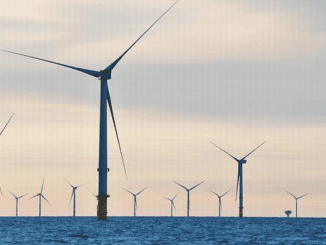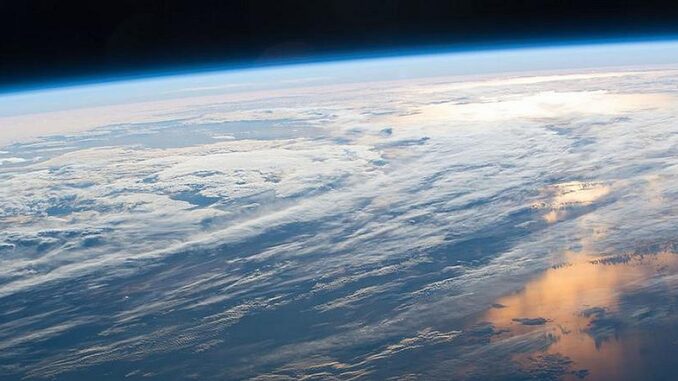
NEW YORK, New York, September 16, 2025 (ENS) – “Forty years ago, nations came together to take the first step in protecting the ozone layer – guided by science, united in action,” said United Nations Secretary-General António Guterres today, in honor of the day in March 1985 when 28 nations agreed on the Vienna Convention for the Protection of the Ozone Layer, the parent treaty behind the Montreal Protocol.
They signed the Montreal Protocol on September 16, 1987 as a global agreement to phase out substances that deplete the ozone layer.
“The Vienna Convention and its Montreal Protocol became a landmark of multilateral success. Today, the ozone layer is healing. This achievement reminds us that when nations heed the warnings of science, progress is possible,” the UN leader said.
After the Montreal Protocol was signed, the phase out of chlorofluorocarbons, CFCs – manufactured chemicals used in refrigeration, aerosol sprays, and foam production – began, and it has continued, helping the ozone layer toward recovery.
On September 16, 2009, the Vienna Convention and the Montreal Protocol became the first treaties in the history of the United Nations to achieve universal ratification.
In Kigali, Rwanda on October 15, 2016, the Parties to the Montreal Protocol agreed to amend the agreement to include the phase down of hydrofluorocarbons (HFCs). These powerful greenhouse gases have a global warming potential thousands of times greater than the most abundant greenhouse gas, carbon dioxide. HFCs are now being phased out under the Kigali Amendment to the Montreal Protocol.
Now, around 99 percent of ozone-depleting substances have been phased out globally through the Montreal Protocol and its amendments, and the ozone layer is showing steady signs of recovery.
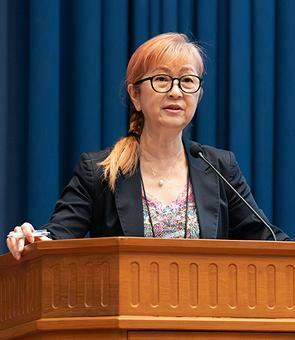
Today, on the annual International Day for the Preservation of the Ozone Layer, the United Nations celebrates this “historic achievement” while looking forward “to another 40 years of action.”
“In the face of a triple planetary crisis – climate, nature and pollution – the Montreal Protocol is one of the best examples we have of the positive and powerful outcome of multilateralism,” Megumi Seki, executive secretary of the UN Environment Programme’s Ozone Secretariat, said in 2021. “When sound science is the basis for universal action, we can overcome what may seem insurmountable global environmental challenges.”
Protective Layer Needs Protection
The ozone layer is a protective film around the Earth that absorbs the Sun’s harmful ultraviolet, UV, radiation and protects all living beings from its damaging effects. Exposure to UV radiation can cause skin cancer and eye cataracts, and damage to crops, plants and micro-organisms, destroying ecosystems and food chains.
But this layer of ozone protecting the Earth was itself in urgent need of protection, scientists warned in the mid-1980s. It was vanishing, leaving a
The discovery of the Antarctic ozone hole was first announced in a paper by British Antarctic Survey’s Joe Farman, Brian Gardiner and Jonathan Shanklin, which appeared in the journal Nature in May 1985.
NASA’s satellite data confirmed that the Antarctic ozone hole was a massive, continent-wide phenomenon.
The scientific confirmation of depletion of the ozone layer prompted the international community to establish a mechanism for cooperation to take action to protect the ozone layer. This was formalized in the Vienna Convention for the Protection of the Ozone Layer, adopted and signed by 28 countries on March 22, 1985. In September 1987, this led to the signing of The Montreal Protocol on Substances that Deplete the Ozone Layer.
‘Every Action Counts’
“I urge governments to fully ratify and implement the Kigali Amendment to the Protocol which commits to phase down hydrofluorocarbons (HFCs) – potent greenhouse gases used primarily in cooling technologies,” UN Secretary-General Guterres said today.
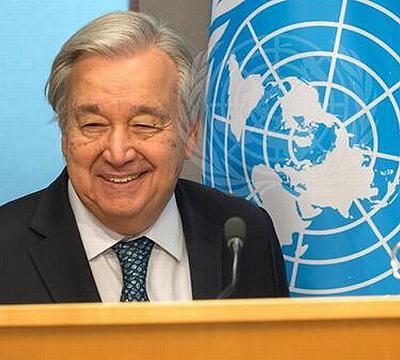
“And I also urge them to reflect this commitment in their new national climate plans – or NDCs. These must be aligned with limiting global temperature rise to 1.5 degrees Celsius and cover all sectors and greenhouse gases, including HFCs,” he said.
“Implementing the Kigali Amendment could avoid up to 0.5 degrees Celsius of warming by the end of the century. Paired with energy-efficient cooling, we could double these gains,” Guterres said. “Every fraction of a degree matters. Every action counts.”
The hole that opens annually in the ozone layer over Earth’s southern pole was relatively small in 2024 compared to other years. Scientists with the U.S. National Aeronautics and Space Administration, NASA, and the National Oceanic and Atmospheric Administration, NOAA, project the ozone layer could fully recover by 2066 due to successful international action under the Montreal Protocol.
This finding was released in the United Nations’ quadrennial scientific assessment of ozone depletion in 2022, with projections based on the continued phasing out of ozone-depleting substances.
“New studies support previous Assessments in that the decline in ODS emissions due to compliance with the Montreal Protocol avoids global warming of approximately 0.5–1 °C by mid-century compared to an extreme scenario with an uncontrolled increase in ODSs of 3 – 3.5 percent per year.
“Actions taken under the Montreal Protocol continue to contribute to ozone recovery. Recovery of ozone in the upper stratosphere is progressing,” the UN assessment states.
Total column ozone, or TCO, is expected to return to 1980 values around 2066 in the Antarctic, around 2045 in the Arctic, and around 2040 for the near-global average (60°N–60°S),” according to the assessment.
Compliance with the 2016 Kigali Amendment to the Montreal Protocol, which requires phase down of production and consumption of some hydrofluorocarbons, HFCs, is estimated to avoid 0.3 – 0.5°C (.6° – .9° F) of warming by 2100.
The Montreal Protocol and Vienna Convention remain crucial for monitoring ozone and UV radiation levels, as well as levels of ozone-depleting substances and other chemicals, such as hydrofluorocarbons.
Common Chemicals Erode the Ozone Layer
A number of commonly used chemicals have been found to be extremely damaging to the ozone layer.
Halocarbons are chemicals in which one or more carbon atoms are linked to one or more halogen atoms such as fluorine, chlorine, bromine or iodine. Halocarbons containing bromine usually have much higher ozone-depleting potential than those containing chlorine.
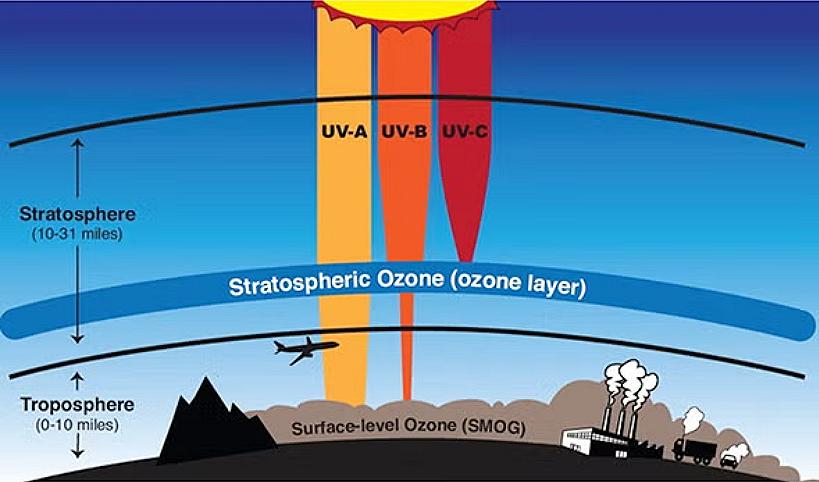
The manufactured chemicals that have released most of the chlorine and bromine that have depleted the ozone layer are methyl bromide, methyl chloroform, carbon tetrachloride, and families of chemicals known as halons, chlorofluorocarbons (CFCs) and hydrochlorofluorocarbons (HCFCs).
The Montreal Protocol is structured around groups of ozone-depleting substances. The groups of chemicals are classified according to chemical family and are listed in annexes to the Montreal Protocol text.
The Protocol requires the control of nearly 100 chemicals. For each group or annex of chemicals, the treaty sets out a timetable for the phase out of production and consumption of those substances, with the aim of eventually eliminating them completely.
The timetable set by the Protocol applies to consumption of ozone depleting substances. Consumption is defined as the quantities produced plus imported, less those quantities exported in any given year. There is also a deduction for verified destruction. Percentage reductions relate to the designated base-line year for the substance.
The Protocol does not forbid the use of existing or recycled controlled substances beyond the phase-out dates.
There are a few exceptions for essential uses where no acceptable substitutes have been found, for example, in metered dose inhalers commonly used to treat asthma and other respiratory problems or halon fire-suppression systems used in submarines and aircraft.
In 1990 the Technology and Economic Assessment Panel, known as TEAP, was established to advise the Parties to the Montreal Protocol. At the request of Parties, TEAP provides technical information related to the alternative technologies that have been investigated and employed to make it possible to virtually eliminate use of ozone depleting substances, such as CFCs and halons, that harm the ozone layer.
Implementation Has Gone Well
Implementation of the Montreal Protocol progressed well in both developed and developing countries. All phase-out schedules were adhered to in most cases, some even ahead of schedule.
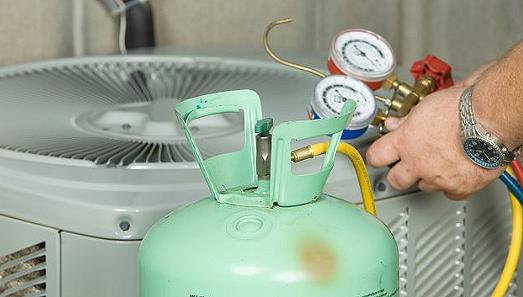
Attention focused initially on chemicals with higher ozone-depletion potentials including CFCs and halons. The phase-out schedule for HCFCs was more relaxed due to their lower ozone-depletion potentials and because they have also been used as transitional substitutes for CFCs.
The HCFC phase-out schedule was introduced in 1992 for developed and developing countries, the latter with a freeze in 2015, and final phase-out by 2030 in developed countries and 2040 in developing countries. In 2007, Parties to the Montreal Protocol decided to accelerate the HCFC phase-out schedule for both developed and developing countries.
On September 10, Saudi Arabia became the latest country to accept the Kigali Amendment to the Montreal Protocol, the 166th country to join.
Montreal Protocol Gets a Revolving Fund
In a move to accelerate global energy efficiency, the Executive Committee of the Multilateral Fund for the Montreal Protocol approved a revolving fund mechanism at its meeting in December 2024.
Aimed at scaling-up the adoption of energy-efficient, low global-warming-potential technologies, a US$40 million funding window was established to support two pilot projects in developing countries, designed to create revolving funds for energy-efficiency end users, such as supermarkets, hotels, cold chain for food and medicines.
These funds, to be transferred to the Multilateral Fund’s implementing agencies, will provide low or zero-interest loans through national financial institutions, enabling those who will benefit from them to invest in energy-efficient, low-global-warming-potential technologies.
Repayments from beneficiaries will replenish the funds, providing an additional cycle of financial support to other beneficiaries. Set to run over an eight-year period, the pilot projects will eventually return the funds to the Multilateral Fund, maximizing the impact of the initial investment.
At its May 2025 meeting, the Executive Committee agreed on the operational modalities of the revolving fund mechanism. The Committee also agreed to support project preparation in Grenada, Thailand, and Türkiye through the World Bank, and a global initiative covering Colombia, Ghana, and Jordan through the UN Development Programme, UNDP. These projects proposals are to be considered in 2026.
For its part, China has eliminated approximately 628,000 tonnes of ozone-depleting substances in production and usage, accounting for over half of the total that has been phased out by developing countries to date, Vice Minister of Ecology and Environment Yu Huiwen said on Tuesday.

Yu made the remarks at a conference in Beijing marking the 40th anniversary of the Vienna Convention for the Protection of the Ozone Layer and the International Day for the Preservation of the Ozone Layer.
China joined the Montreal Protocol on Substances that Deplete the Ozone Layer in 1991 and accepted the Kigali Amendment in 2021, strengthening its control over non-carbon-dioxide greenhouse gases like hydrofluorocarbons. As a key participant of the convention and protocol, China has made significant contribution to the recovery of the ozone layer and addressing climate change, he said.
Yu said that China will continue to support ozone layer protection, climate response and sustainable development worldwide through measures such as improved policy frameworks and enhanced international cooperation.
UN Secretary-General Guterres is hopeful. “UN week offers every possibility for dialogue and mediation. Every opportunity for forging solutions. Thousands of leaders’ meetings will take place. I will hold over 150 bilateral meetings myself. I will use every one of them to press leaders to contact each other, to speak directly with each other. To bridge divides. To reduce risks. To find solutions. To get serious,” said the secretary-general.
“Scientists estimate that the hole in the ozone layer will be no more by the 2060s,” said Meg Seki from the Ozone Secretariat. “However, it’s very difficult to talk about complete recovery because the atmosphere itself is very different to what it was when there was no ozone depletion. Greenhouse gases, temperature changes and global warming all affect the dynamics and chemical processes in the atmosphere, impacting the recovery process. In other parts of the stratosphere, the ozone layer recovery is expected to be earlier.”
Ozone depletion is not limited to the area over the South Pole. Research has shown that ozone depletion occurs over the latitudes that include North America, Europe, Asia, and much of Africa, Australia, and South America. More information about the global extent of ozone depletion can be found in the Scientific Assessment of Ozone Depletion: 2018 developed by the United Nations Environment Programme.
Featured image: The ozone layer, a thin shield of gas, is seen from space. Found high in Earth’s atmosphere, the ozone layer shields the planet from most of the Sun’s ultraviolet rays. undated (Photo courtesy NASA)
© 2025, Environment News Service. All rights reserved. Content may be quoted only with proper attribution and a direct link to the original article. Full reproduction is prohibited.



